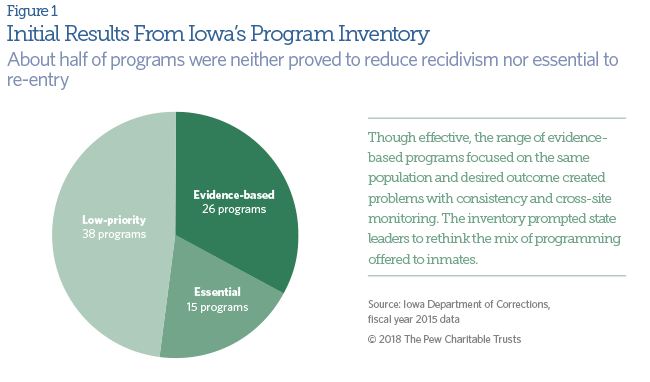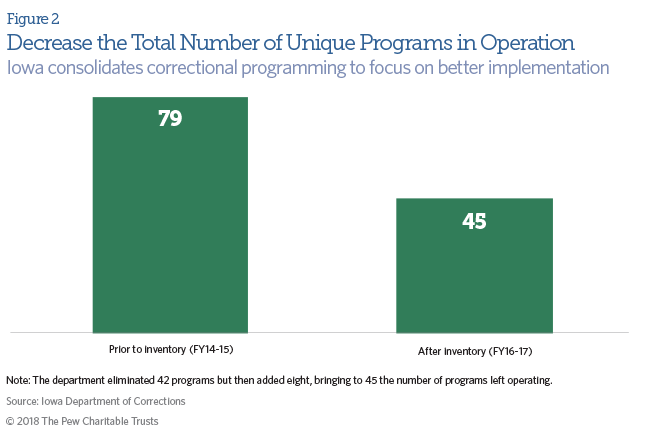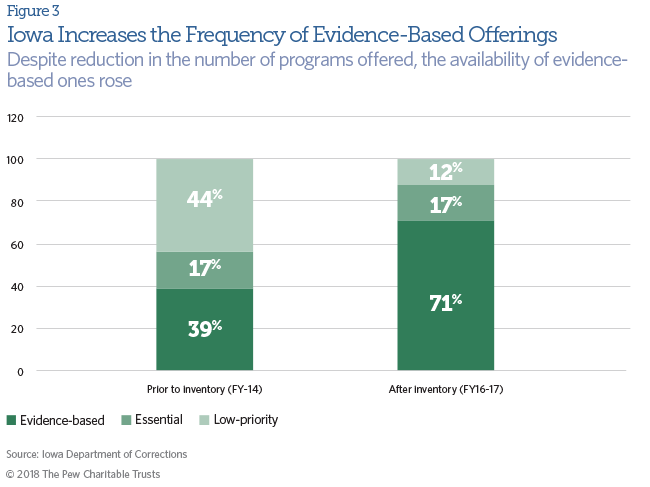Iowa’s Department of Corrections Takes an Innovative, Evidence-Based Approach
Efforts targeted toward programs that reduce recidivism, improve successful re-entry into community
Overview
When departments of corrections target services to people who are incarcerated, these services can help reduce the likelihood that those individuals will engage in criminal activity when released. Too often, however, criminal justice agencies lack the information they need to know whether the programs they offer to inmates are effective. In Iowa, corrections leaders have pursued an innovative approach that allows the best available research to guide their choices.
Through its partnership with the Pew-MacArthur Results First Initiative, the Iowa Department of Corrections conducted an inventory of its current programs, collected data on their design and capacity, and used rigorous research studies to categorize programs by the likelihood that they will reduce recidivism.
The process has enabled corrections leaders to:
- Identify which programs contribute to successful re-entry and recidivism reduction. With the help of Results First technical assistance, the Iowa Department of Corrections created a detailed inventory of all 79 programs across its facilities. The analysis—which reviewed the evidence supporting existing programs, along with their capacity and purpose—revealed that nearly half of the programs were neither evidence-based nor essential to re-entry, and that the sheer number in operation made consistent implementation across facilities difficult.
- Shift resources to effective programs that better support department goals. Working with staff and wardens, corrections leaders developed and implemented a set of recommendations to consolidate the number of programs in operation while increasing the share of resources going to evidence-based options. The department discontinued 42 programs (primarily those that did not aid in re-entry or help reduce recidivism) and reallocated staff to increase the availability of interventions that the inventory had identified as evidence-based.
- Institute new policies and procedures to sustain evidence-based policymaking. The overall reduction in programs, coupled with an ongoing focus on allocating staff resources to those shown to reduce recidivism, has enabled the Iowa Department of Corrections to develop new policies and procedures to sustain this work, including a process to ensure consistent implementation of programs across facilities and screening to reliably identify services that have proved effective.
This case study highlights these successes and includes lessons learned for other jurisdictions interested in increasing their investment in evidence-based programs.
Developing a Results First Program Inventory
The Pew-MacArthur Results First Initiative, a project of The Pew Charitable Trusts and the John D. and Catherine T. MacArthur Foundation, works with states and localities to develop and implement tools to identify and fund what works. A program inventory is one such tool. Through training and technical assistance, jurisdictions learn to develop a comprehensive list of the interventions they operate; collect relevant data on program design, costs, capacity, and populations served; and use rigorous research studies to categorize programs by their likelihood of achieving desired outcomes. Once jurisdictions have completed their inventory, they can use the Results First Clearinghouse Database—an online collection of information from eight national clearinghouses that conduct independent, transparent, systematic, and rigorous reviews of available research—to assess their own programs’ effectiveness.
Identify which programs contribute to successful re-entry and recidivism reduction
The Iowa Department of Corrections partnered with the Pew-MacArthur Results First Initiative in 2011 with a strong commitment to evidence-based principles and a history of using research in the management and rehabilitation of offenders. Results First offered corrections staff and leadership a unique opportunity to build their capacity to measure and evaluate their investments in evidence-based programs, to identify the most cost-beneficial options for reducing recidivism, and to consistently interpret the research support for new and homegrown programs.
With help from Results First technical and policy staff, corrections staff focused initially on implementing a state-specific cost-benefit model that estimated the returns on investment produced by 20 prison-based and community-based programs. The model identified several programs as good investments—with benefits ranging from $2.91 for correctional education to $37.70 for prison-based cognitive behavioral therapy for every dollar invested1—while other programs were found to have little impact or had costs that exceeded their benefits. These findings prompted a number of funding shifts, to move resources away from programs that proved ineffective and toward those with stronger evidence of effectiveness.2 “The Results First approach and tools helped us identify evidence-based programs that were proven to reduce recidivism and had a significant return on investment,” said Jerry Bartruff, director of the Department of Corrections. “By investing in those programs, we created opportunities for people in prison to be successful when returning to the community.”3
Iowa’s early success with cost-benefit analysis prompted a desire to categorize all inmate programs—not just the few for which data were available to calculate their projected returns on investment—by their expected impact on recidivism. To conduct this assessment, the department first needed a complete, up-to-date inventory of the programs it offered. The state’s inmate management database, ICON, provided such a list, but issues with inconsistent and infrequent data entry made program information unreliable for decision-makers. “Our agency was committed to evidence-based programs, but we struggled to differentiate them from other core practices,” said Katrina Carter, director of re-entry and treatment services. “We needed a systematic way to get rid of the clutter and fix our patchwork of programs.”4 A Bureau of Justice Assistance Second Chance Act grant, made available through the U.S. Department of Justice, provided the resources for conducting the program inventory work, part of a comprehensive statewide recidivism reduction effort.
Using program inventory templates and technical resources under the guidance of Results First staff, agency analysts worked with treatment directors to examine and classify the programs listed in ICON. Review teams began by identifying programs that could be removed from the database—either because they were no longer offered or because they had very low participation rates. At the time of this review, ICON housed more than 200 unique programs being offered in facilities—many of which, administrators suspected, were no longer in use or duplicated other services. Eliminating legacy records was a relatively straightforward and uncontroversial process: “No one had to say, ‘You’re not going to do this anymore,’” said Anne Brown, coordinator of domestic abuse programs and co-chair of the department’s quality assurance committee. “Programs went away [as] wardens saw the low attendance rates and dropped them on their own.”5
After this initial sort was complete, review teams turned to classifying the remaining 79 programs into three categories. (See Figure 1.)
|
Evidence-based programs shown to reduce recidivism |
ICON contained a field for distinguishing proven approaches, but the classification system was outdated and used inconsistent methods for establishing categories.6 To revise it, staff used a number of sources, including the Results First Clearinghouse Database, to identify which programs matched evidence-based models. The department identified 26 evidence-based programs offered across its facilities. |
|
Essential programs that aid in re-entry |
Staff examined the remaining 53 programs to identify those essential to inmate functioning, such as psychiatric treatment and employment readiness, despite not being proved to affect recidivism. The department identified 15 essential programs offered across its facilities. |
|
Low-priority programs neither proved effective nor deemed essential |
The remaining programs did not have a proven impact on recidivism and were not considered essential to re-entry or sentence completion. These low-priority programs included those focused on family support, certain types of job training programs, and personal development activities. The department identified 38 low- priority programs offered across its facilities. |
The inventory quantified what administrators and staff knew intrinsically: The sheer number of programs offered made consistent service delivery within and across facilities nearly impossible. As a result, some evidence-based models were likely not operating as designed—and not generating outcomes as expected. The department decided to reduce the total number of programs offered to ensure effective implementation.
The inventory also revealed that approximately half of current programs neither aided in recidivism reduction nor helped transition inmates to the community. While these programs are important in overall offender management and often affect other domains of an individual’s life (such as family functioning), they were consuming valuable staff resources that could be directed to interventions providing a higher likelihood of success—and a higher return on investment. “We were surprised to see how many low-priority programs were being offered, occupying offenders’ time and staff time, too,” said Lettie Prell, research director for the department.7 Staff workload studies reinforced this finding; Iowa had invested considerable time and resources in programs that did not help it meet its core goal of recidivism reduction.8 The department decided to shift existing resources toward evidence-based programs.
Shift resources to effective programs to better support department goals
Armed with two key objectives—to decrease the overall number of unique programs in operation and to increase the proportion of resources dedicated to evidence-based options—department leadership worked with staff and wardens to develop a set of recommendations that would reallocate workers to help meet the department’s core goal of reducing recidivism. To engage personnel in the process, administrators organized a number of working groups, identified supportive individuals who could be cultivated as advocates in the facilities, and provided frequent updates to staff.
The process of identifying which programs to discontinue was challenging. Some proposals were more difficult to move forward than others, particularly when high-need populations or sensitive crimes were involved. “Staff were emotionally invested in some programs,” said Director Carter. “[Our solution was to work together] to acknowledge our shared goal of offender rehabilitation and safer communities, and that some programs are not effective at achieving those goals.”9
In addition to gaining consensus around department goals, communication focused on time management: Staff were busy, but not always with programs that reduce recidivism. “It became easier for staff to give up pet projects when they had data showing that those programs are not effective and that their time is limited,” said Daniel Craig, deputy director of institution operations.10
Following these discussions, officials reassigned paid corrections employees to evidence-based and essential programs, and phased out or transitioned to volunteer-led any programs that did not contribute to the larger goal of recidivism reduction. Staff received extensive training in the program models that were selected.
Resources were allocated to support programs that met the assessed risks and needs of each facility’s population, organized around four key domains of offender management:
- Cognitive skills and restructuring: At the time of the inventory, the department was operating several evidence-based programs designed to address participants’ negative thought patterns. While some of these programs were unique to the population they served, most followed a similar model, with slight variations that made consistent implementation across facilities difficult. To address this issue, leaders opted to consolidate most of these programs and train staff to deliver a single evidence-based intervention—known as Thinking for a Change11—while maintaining or expanding only those programs targeting a specific population, such as the cognitive-based Achieving Change Through Value-Based Behavior, a program designed for domestic violence offenders.12
- Education and career development: Corrections officials identified a number of vocational education and apprenticeship programs that research shows reduces participants’ likelihood of reoffending. Many of these programs were taught by a certified instructor and therefore adhered to a set curriculum, but others were not as well-organized or well-implemented. Uncertified programs were eliminated, along with generic job readiness programs not focused on developing a specific skill or vocation.
- Behavioral health: The department offered 28 mental health and substance use models across its facilities, of which only nine were evidence-based and nine others were essential to re-entry. As with cognitive programming, the varied models made uniform service delivery difficult. The department consolidated the number of substance use programs it offered, replacing most with a single model—Cognitive Behavioral Interventions for Substance Abuse—that researchers had found effective through independent evaluation.13
- Re-entry and protective factors: About a quarter of all program models—19 of 79—focused on supporting re-entry and community re-engagement, such as anxiety management, financial literacy, parenting and family classes, and service navigation. Of these offerings, none were evidence-based or essential to re-entry. The department discontinued 10 of these programs, with the remainder transitioned to a volunteer-led operation.
Overall, the department reduced the number of programs offered in its facilities from 79 to 45 between fiscal year 2015 and fiscal 2017, as shown in Figure 2, and met its first objective. The substantial reduction in programs generated a mixed response from staff. Some understood the reasoning immediately, yet others were concerned that the change would mean a loss in programs that, while not effective at reducing recidivism, were effective at occupying inmates’ time. “It wasn’t easy,” said Beth Skinner, director of risk reduction. “But we knew if we wanted to improve public safety, we had to make hard decisions. We needed to be more thoughtful with our resources and focus on recidivism reduction.”14
The reduction in program options allowed leaders to tackle their second goal: investing staff time more strategically in interventions shown to be most effective at addressing a particular need within the population. For example, despite offering fewer distinct evidence-based programs, the Iowa prison system offered these interventions more frequently, increasing opportunities to access them. Low-priority programs, also reduced in number, were offered much less frequently throughout the institutions and staffed with volunteers in lieu of paid corrections employees. (See Figure 3.)
This movement of resources can be monetized over time. Since Results First work began in fiscal 2011–12, the department has shifted $3.8 million to evidence-based programming within its facilities, with minimal change in overall program spending.15 Corrections leaders also note an increase in the percentage of inmate course enrollments in evidence-based programs from 31 percent in fiscal 2011–12 to 46 percent in fiscal 2015–16.
To explain the department’s shift of resources toward evidence-based programs, the department issued a number of plans and updates, including regular reports to wardens detailing, for example, the average length of stay in the facility, the assessed risks and needs of the population, and a list of current and inactive programs. This information has been useful to wardens, who often did not have such data organized in a single location, and has been incorporated into the annual reports of a number of facilities. For example, the North Central Correctional Facility used its fiscal 2016 annual report to highlight its discontinuation of Victim Impact (an ineffective program) and its plans to expand Thinking for a Change and Achieving Change Through Value-Based Behavior, two evidence-based programs.16 “The program inventory got us [wardens] talking about the needs within our institutions [for] evidence-based programs [and not just activities] to keep idle hands busy,” said Sheryl Dahm, warden of the Iowa Correctional Institute for Women. “It got us from sitting on committees to taking action.”17
It’s better to do a few programs well than to try to do everything.Anne Brown, coordinator of domestic abuse programs, Iowa Department of Corrections
Institute new policies and procedures to sustain evidence-based policymaking
The consolidation of programs, coupled with a sustained focus on allocating staff resources to evidence-based options to reduce recidivism, has motivated the department to develop a number of new policies and procedures to support consistent operations across facilities. Moving forward, the department anticipates that these improvements will pay dividends by increasing the likelihood that offenders will successfully return to the community and stay out of the corrections system.
Fidelity monitoring
With fewer programs in operation, the Iowa Department of Corrections is now able to focus on consistent and effective program implementation across facilities. Leaders in the department cited a number of issues with fidelity—the extent to which a program adheres to its original design—that affected their likelihood of achieving desired results. For example, a number of facilitators, though trained in a particular model, had adapted it based on their teaching style and their desire to make the curriculum more relatable to inmates. In the past, these modifications either went unnoticed or were encouraged. Mike Boatman, quality assurance coordinator, explained that, “in the past, when treatment providers deviated from the model, [they often received positive feedback], validating the modifications. To change this behavior, [we knew that] our new quality assurance process [would have to be] very intentional.”18
The department has developed an internal fidelity monitoring device, known as the IOWA tool, that assesses program administration (such as group size) and facilitation (such as the professional conduct of staff who lead classes). Quality control staff score each indicator on a scale from 1 to 4 and enter the results in a database, which sends facilitators a report on their strengths and areas for growth. The tool has been piloted on a number of programs and garnered preliminary support from treatment staff. “We’ve seen a real change,” said Roxann Scheffert, quality assurance coordinator. “Facilitators are [seeking] feedback from the central office and seeing [fidelity monitoring] as an avenue to do better.”19 Corrections leaders plan to roll out the IOWA tool to all programs.
Ongoing program review
Before any new program can be implemented in a facility, staff must now submit a series of forms that specify the type of program being proposed, its impact on department resources, and the research basis for its effect on recidivism. Central office staff use these forms to classify programs as “evidence based,” “essential,” or “low priority,” and have the option to approve, deny, or request more information before new programs are approved and entered in ICON. In addition to this ongoing vetting, the agency plans to review ICON annually to ensure that the database continues to supply accurate program data. The current version of these screening tools can be found in the appendix.
To ensure that evidence-based programs operate as intended and achieve desired outcomes, the department plans to conduct regular, rigorous program evaluation. The state has forged a number of partnerships with local universities, and it plans to evaluate several programs in the fall and winter of 2017. Programs are scheduled to be re-evaluated every five years. “Because we have fewer programs, it doesn’t feel like a herculean effort to evaluate them or monitor them for fidelity,” said research director Prell.20
Lessons learned
A variety of factors have supported Iowa’s successful development and use of the Results First program inventory. Agency leaders point to three key actions—maximizing existing resources, focusing on results, and committing to ongoing review—that other states might consider when embarking on this work.
- Maximizing existing resources: The Iowa Department of Corrections substantially increased the number of evidence-based programs it operated—and did so with minimal changes to overall spending. Instead it made sure that paid corrections employees were being used to staff evidence-based and essential programs, and it phased out or transitioned to volunteer-led those programs that did not contribute to the larger goals of recidivism reduction and successful re-entry. “Cost-effective use of available resources should drive the conversation,” said Director Bartruff. “We can demonstrate that by investing in programs that are proven to reduce recidivism and discontinuing programs that are not, we can deliver effective programs with available resources.”21
- Focusing on results and communicating changes: Leadership’s clear, consistent commitment to recidivism reduction was crucial for making these resource shifts, particularly when discontinuing programs favored by staff. Administrators worked hard to explain the rationale behind decisions, and stuck to those decisions even when unpopular. “The key to our success was stepping back and starting with commitment at the top and focusing on what is important to the agency, then taking that down to staff,” said Deputy Director Craig. As part of its commitment to results, the agency also phased out a number of evidence-based models, opting to focus resources on a single program implemented consistently across sites.
- Committing to ongoing review: The program inventory was not a one-time exercise; it has been incorporated into the state’s inmate management system and will be reviewed annually to facilitate ongoing tracking of program operations. Regular fidelity monitoring and evaluation—enabled by the reduction in program models operated by the department—will ensure that programs achieve desired outcomes.
Appendix: Program review
Program/activity screening checklist
Identify which of the following categories the proposed program is designed to address:
|
Questions
- Is the proposed program led by Department of Corrections (DOC) staff, non-DOC staff, or volunteers?
- If DOC staff-led, how many staff are involved?
- If volunteer-led, please provide institutional policy/practice for training and providing continuous quality improvement/quality assurance for volunteer-led groups.
- Is the proposed intervention court-ordered?
- Explain anticipated impact this will have on other class waiting lists.
Endnotes
- Pew-MacArthur Results First Initiative, “Iowa’s Cutting-Edge Approach to Corrections” (2013), http://www.pewtrusts.org/~/media/legacy/uploadedfiles/pcs_assets/2013/ rfibriefresultsfirstiowaprogressreportfinalpdf.pdf.
- For example, the agency replaced a community-based domestic violence program projected to lose $3 for every dollar invested with a research-informed program found to be effective through subsequent evaluation by University of Iowa. For more information, see Pew- MacArthur Results First Initiative, “Iowa’s Cutting-Edge Approach to Corrections.”
- Pew-MacArthur Results First Initiative panel interview, April 12, 2017.
- Ibid
- Ibid
- Programs have been categorized by their evidence base since 2009, as required by the state’s Accountable Government Act. For more information, see Iowa Department of Corrections, “2016 Annual Report” (2016), https://doc.iowa.gov/sites/default/files/documents/2017/01/ fy16_doc_annual_report_1.pdf.
- Pew-MacArthur Results First Initiative panel interview, April 12, 2017.
- Iowa Department of Corrections, “Prison Programs Findings & Recommendations” (2016).
- Pew-MacArthur Results First Initiative panel interview, April 12, 2017.
- Ibid
- Iowa Department of Corrections, “Iowa Program Inventory Final Report: Offender Services” (2017).
- Ibid
- Ibid
- Pew-MacArthur Results First Initiative panel interview, April 12, 2017.
- The state has also expanded its community-based domestic violence program, Achieving Change Through Value-Based Behavior, dedicating $4.85 million to the evidence-based model since fiscal year 2011–12.
- Iowa Department of Corrections, “North Central Correctional Facility 2016 Annual Report” (2016), https://doc.iowa.gov/sites/default/files/documents/2017/03/ nccf_annual_report_fy16.pdf.
- Pew-MacArthur Results First Initiative panel interview, April 12, 2017.
- Ibid
- Ibid
- Ibid
- Ibid













